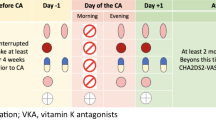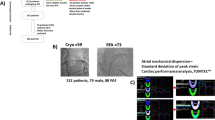Abstract
Background and purpose
To investigate the independent predictors of immediate success for atrioventricular nodal reentry tachycardia (AVNRT) catheter ablation in patients without accelerated junctional rhythm (JR).
Methods
The study included 172 consecutive patients with AVNRT undergoing slow pathway ablation that had no JR during the radiofrequency pulses. The diagnosis of AVNRT was made using the classic criteria of documenting antegrade atrio–His or retrograde ventriculoatrial (VA) jump and arrhythmia induction. Successful ablation was defined as the inability to induce tachycardia with and without the infusion of isoproterenol and the absence of more than one AV-nodal echo.
Results
The clinical independent predictors of successful ablation in the studied patients were identified as age ≥60, ablation-site location (mid-septal rather than posteroseptal), and baseline heart rate ≥100 beat per minute. The predictive performance of the risk model was very good and the calibration of the risk model was acceptable.
Conclusions
Our study suggests predictive factors that can be used to gauge procedural success in AVNRT patients without accelerated JR during ablation.

Similar content being viewed by others
References
Rostock, T., Risius, T., Ventura, R., et al. (2005). Efficacy and safety of radiofrequency catheter ablation of atrioventricular nodal reentrant tachycardia in the elderly. Journal of Cardiovascular Electrophysiology, 16, 608–610.
Meiltz, A., & Zimmermann, M. (2007). Atrioventricular nodal reentrant tachycardia in the elderly: efficacy and safety of radiofrequency catheter ablation. Pacing and Clinical Electrophysiology, 30(Suppl 1), S103–S107.
Topilski, I., Rogowski, O., Glick, A., Viskin, S., Eldar, M., & Belhassen, B. (2006). Radiofrequency ablation of atrioventricular nodal reentry tachycardia: a 14-year experience with 901 patients at the Tel Aviv Sourasky Medical Center. The Israel Medical Association Journal, 8, 455–459.
McGavigan, A. D., Rae, A. P., Cobbe, S. M., & Rankin, A. C. (2005). Junctional rhythm—a suitable surrogate endpoint in catheter ablation of atrioventricular nodal reentry tachycardia? Pacing and Clinical Electrophysiology, 28, 1052–1054.
Li, H. G., Klein, G. J., Stites, H. W., et al. (1993). Elimination of slow pathway conduction: an accurate indicator of clinical success after radiofrequency atrioventricular node modification. Journal of the American College of Cardiology, 22, 1849–1853.
Jais, P., Haissaguerre, M., Gencel, L., Pocquet, F., Le Metayer, P., & Clementy, J. (1995). Management of nodal reentrant tachycardia with radiofrequency: predictive criteria of success. Archives des Maladies du Coeur et des Vaisseaux, 88, 1849–1854.
Kawaguchi, N., Kobayashi, Y., Miyauchi, Y., Atarashi, H., Takano, T., & Hayakawa, H. (1999). Incidence and clinical significance of junctional rhythm remaining after termination of radiofrequency current delivery in patients with atrioventricular nodal reentrant tachycardia. Japanese Circulation Journal, 63, 865–872.
Strickberger, S. A., Daoud, E. G., Niebauer, M. J., Hasse, C., Man, K. C., & Morady, F. (1996). The mechanisms responsible for lack of reproducible induction of atrioventricular nodal reentrant tachycardia. Journal of Cardiovascular Electrophysiology, 7, 494–502.
Hsieh, M. H., Chen, S. A., Tai, C. T., Yu, W. C., Chen, Y. J., & Chang, M. S. (1998). Absence of junctional rhythm during successful slow-pathway ablation in patients with atrioventricular nodal reentrant tachycardia. Circulation, 98, 2296–2300.
Akhtar, M., Jazayeri, M. R., Sra, J., Blanck, Z., Deshpande, S., & Dhala, A. (1993). Atrioventricular nodal reentry. Clinical, electrophysiological, and therapeutic considerations. Circulation, 88, 282–295.
Jackman, W. M., Beckman, K. J., McClelland, J. H., et al. (1992). Treatment of supraventricular tachycardia due to atrioventricular nodal reentry by radiofrequency catheter ablation of slow-pathway conduction. New England Journal of Medicine, 327, 313–318.
Thibault, B., de Bakker, J. M., Hocini, M., Loh, P., Wittkampf, F. H., & Janse, M. J. (1998). Origin of heat-induced accelerated junctional rhythm. Journal of Cardiovascular Electrophysiology, 9, 631–641.
Boyle, N. G., Anselme, F., Monahan, K., et al. (1997). Origin of junctional rhythm during radiofrequency ablation of atrioventricular nodal reentrant tachycardia in patients without structural heart disease. The American Journal of Cardiology, 80, 575–580.
Jentzer, J. H., Goyal, R., Williamson, B. D., et al. (1994). Analysis of junctional ectopy during radiofrequency ablation of the slow pathway in patients with atrioventricular nodal reentrant tachycardia. Circulation, 90, 2820–2826.
Poret, P., Leclercq, C., Gras, D., et al. (2000). Junctional rhythm during slow pathway radiofrequency ablation in patients with atrioventricular nodal reentrant tachycardia: beat-to-beat analysis and its prognostic value in relation to electrophysiologic and anatomic parameters. Journal of Cardiovascular Electrophysiology, 11, 405–412.
McGuire, M. A., de Bakker, J. M., Vermeulen, J. T., et al. (1996). Atrioventricular junctional tissue. Discrepancy between histological and electrophysiological characteristics. Circulation, 94, 571–577.
Nikoo, M. H., Emkanjoo, Z., Jorat, M. V., et al. (2008). Can successful radiofrequency ablation of atrioventricular nodal reentrant tachycardia be predicted by pattern of junctional ectopy? Journal of Electrocardiology, 41, 39–43.
Cooper, L. L., Odening, K. E., & Hwang, M. S. (2012). Electromechanical and structural alterations in the aging rabbit heart and aorta. American Journal of Physiology Heart and Circulatory Physiology, 302(8), H1625–H1635.
Waki, K., Kim, J. S., & Becker, A. E. (2000). Morphology of the human atrioventricular node is age dependent: a feature of potential clinical significance. Journal of Cardiovascular Electrophysiology, 11, 1144–1151.
Estner, H. L., Ndrepepa, G., Dong, J., et al. (2005). Acute and long-term results of slow pathway ablation in patients with atrioventricular nodal reentrant tachycardia—an analysis of the predictive factors for arrhythmia recurrence. Pacing and Clinical Electrophysiology, 28, 102–110.
Khairy, P., Novak, P. G., Guerra, P. G., et al. (2007). Cryothermal slow pathway modification for atrioventricular nodal reentrant tachycardia. Europace, 9, 909–914.
Li, Y. G., Bogun, F., Grönefeld, G., & Hohnlose, S. H. (1998). Randomized comparison of slow pathway modification within the posteroseptal versus the midseptal area in patients with atrioventricular nodal reentrant tachycardia. American Journal of Cardiology, 82(10), 1287–1290.
Author information
Authors and Affiliations
Corresponding author
Rights and permissions
About this article
Cite this article
Bagherzadeh, A., Keshavarzi, T., Farahani, M.M. et al. Determinants of immediate success for catheter ablation of atrioventricular nodal reentry tachycardia in patients without junctional rhythm. J Interv Card Electrophysiol 39, 19–23 (2014). https://doi.org/10.1007/s10840-013-9839-x
Received:
Accepted:
Published:
Issue Date:
DOI: https://doi.org/10.1007/s10840-013-9839-x




